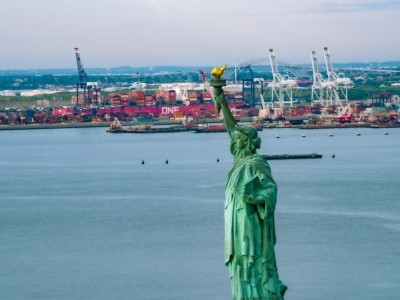Port Authority starts construction on 4th phase of container terminal
Nov 01, 2024
The terminal expansion will more than double capacity and enhance efficiency.
Today, the Alabama Port Authority announced the commencement of the fourth phase of its container terminal expansion, which will double the capacity of the container terminal from half a million to over one million twenty-foot equivalent units (TEUs) a year.
As the fastest-growing container terminal in the United States over the last six years, the Port of Mobile continues to set new productivity and customer service standards. In addition, Forbes recently named the Port of Mobile the second fastest-growing port of entry to the United States over the past decade.
"The launch of the fourth phase of our container terminal expansion marks another transformative step for the Port of Mobile,” said John Driscoll, Director and CEO of the Alabama Port Authority. “As trade patterns continue to evolve, this expansion ensures that we remain a reliable, efficient, and sustainable gateway for commerce. We are investing to ensure the Port of Mobile meets the needs of current and future business partners across the globe and enhances our role as a key driver of Alabama’s economy.”
The partnership with terminal operator APM Terminals Mobile is a multi-year development initiative aimed at boosting the terminal's capacity, operational efficiency, and ability to serve the growing demands of both domestic and international trade. While turn times for drivers at ports nationwide average anywhere from two to three hours, Mobile has a unique competitive advantage, with drivers at the Port of Mobile typically completing their dual transactions in just 45 minutes or less.
This latest phase, which will include an inter-terminal connector bridge to create on-dock rail access at the container terminal, is the result of $200 million in federal funding championed by former Senator Richard Shelby and underscores the Port’s commitment to establishing Mobile as a premier logistics hub for the Southeast and beyond.
This expansion is complemented by the Port of Mobile’s ongoing channel deepening and widening project, led by the U.S. Army Corps of Engineers, which will increase the Mobile Ship Channel depth to 50 feet, allowing the terminal to accommodate larger vessels carrying more significant cargo volumes. The expanded terminal and deeper channel will allow the Port to serve “super-post Panamax” vessels – the largest ships that can transit the expanded Panama canal – and improve connectivity to major inland markets through enhanced rail and road infrastructure.
“From the deepening and widening of the ship channel to the expansion of our terminal, our growth and efficiency are direct results of investments made by Governor Ivey, and former Senator Richard Shelby, our federal delegation, and state legislature,” said Driscoll. “These partnerships show the enduring commitment from our partners to expanding Alabama’s trade capacity, enabling us to bring world-class service to our customers and create meaningful jobs in every corner of Alabama and beyond.”
“This increased capacity will enable APM Terminals in Mobile to continue as one of the country’s fastest growing and most efficient ports serving existing and new customers and markets in the state of Alabama and states beyond,” said Brian Harold, Managing Director of APM Terminals. “With our global expertise in high-productivity customer-oriented terminals, we are committed to operational excellence and environmental sustainability, thus cementing the port of Mobile’s position as a best-in-class, reliable gateway for key U.S. markets and as a competitive logistics hub.”
Through federal investments and the public-private partnership between the Port Authority and APMT, more than $1 billion in capital expansion projects for containerized cargo are underway statewide.
In addition to the terminal expansion and the harbor deepening and widening project, the Alabama Port Authority plans to develop logistics facilities in Mobile and open a new inland intermodal facility served by CSX in Montgomery, Alabama. These projects will begin operation within the next two years, providing new advantages and opportunities for shippers.
Other planned investments include modernizing general cargo piers and developing an inland intermodal facility in Decatur, Alabama. Beyond public funding from federal grants and the Alabama State Legislature, the Port reinvests all revenue outside of operating expenses in improving and expanding its facilities.
The Port of Mobile is strategically located in the northern Gulf of Mexico with access to an international airport and two interstate systems, I-65 running north/south and I-10 running east/west. The ICTF at the Port of Mobile provides access to five Class I and four short-line railroads. From Mobile, containers can reach Chicago in three days.
The Alabama Port Authority serves all 67 counties in the state of Alabama and oversees the deep-water public port facilities at the Port of Mobile. In addition to interstate, air, and rail, the Port Authority’s container, general cargo, and bulk facilities have immediate access to nearly 15,000 miles of inland waterways. Once the channel deepening and widening project is completed, the Port of Mobile will be the deepest container terminal in the Gulf of Mexico.
Similar Stories

Port of Seattle Statement on importance of industrial lands
View Article
Port of Los Angeles processed 10.3 million TEUs in 2024
View Article
Port Authority to outilne upcoming PATH Hoboken Station closure, detail alternate travel options
View Article
Georgia Ports welcomes Wallenius Wilhelmsen’s new Brunswick hub facility
View Article
Port of Los Angeles Executive Director Gene Seroka outlines successes, priorities at ‘State of Port Event’
View ArticlePort Houston surpasses $1B in awards to small, minority, and women-owned businesses
Port Houston is proud to announce a significant milestone in its commitment to equity and economic opportunity: More than $1.1 billion has been awarded in contracts with Small, Minority, and…
View ArticleGet the most up-to-date trending news!
SubscribeIndustry updates and weekly newsletter direct to your inbox!





